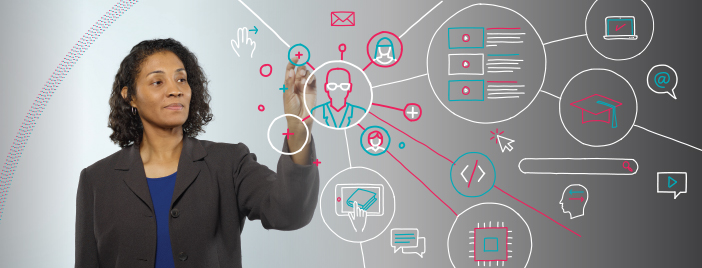
Nicol Howard, who instructs future teachers in U of R’s School of Education, increasingly sees her role as a “guide on the side,” helping students to navigate the limitless landscape of information and to engage with digital tools that provide a richer learning experience. (Photo by William Vasta; Illustration by iStock.com/varijanta)
he instructor-centered classroom—where students are tasked with simply absorbing what they’re told—has gone the way of the typewriter and the rotary phone for tech-savvy educators like Nicol Howard, who instructs future teachers in the University of Redlands School of Education.
“Students are becoming the curators of content for their own learning now,” Howard says. “They’re becoming [their own]advocates as they learn how to use technology to seek out more content for themselves. I think that’s a huge shift.”
Online learning is only one side of a transformation also playing out within in-person education.
As recently as a few years ago, technology in the classroom might mean flashing PowerPoint slides to accompany her lecture, Howard says. Now, she sees her role as more of a facilitator, a “guide on the side,” helping students to navigate the limitless landscape of information and to engage with digital tools that provide a richer learning experience.
One increasingly popular tech-related strategy is the “flipped classroom,” in which an instructor videotapes a lecture that students watch at home, freeing up classroom time for group projects and working on assignments with the teacher present to provide support. Howard, who spent years teaching at the K-12 level in the Compton, Santa Ana, and Corona-Norco school districts, says a flipped classroom is potentially helpful for students who have families and parents who work long hours with limited time at home to help students with schoolwork. In lieu of homework at home, students watch video presentations from their teacher and return to class the next day to work through projects.
Looking to the time when these future educators take the helm of science and art classrooms themselves, Howard—who loved tinkering with electronics as a kid—introduces them to tools including the Makey Makey line of invention kits, which can turn everyday objects—think Play Doh and bananas—into touchpads and combine them with the internet.
Following her example, Howard’s students create lesson plans that combine video, Google Docs, and other technology with more traditional methods such as printed material and classroom discussion.
The key, Howard says, is to not get distracted by the flashiest or most popular innovation.
“We talk about, ‘why is that tool important?’” she says. “’What can I achieve without that technology tool? What can I achieve with the technology tool? How will this enhance the students’ learning if I were to use this in my own class?’”
Howard likewise encourages her students—and by extension her students’ students—to rise to the challenge of being informed consumers of information by cultivating a discerning eye when performing research on the internet. Working together, members of Howard’s classes develop a rubric to evaluate online sources, with factors including confirmation from multiple sources, credibility of the authors, and how long the site has existed.
Howard says teachers now more than ever need to be experts in their field to guide students through the increasingly sophisticated information available online. At the same time, they must become comfortable admitting they don’t have all the answers when a student’s own research raises an unexpected question.
“With a lecture you can feel that you’re pulling the class,” she says. “Now I feel that we’re moving together.”



